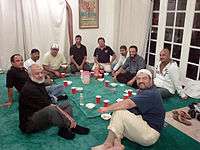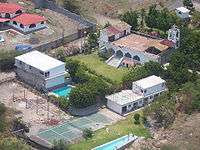Islam in Mexico

There is a lot of information about the origins of Islam in Mexico, but most sources claim it arrived with either Lebanese, Saudi Arabian, Yemeni or Syrian immigrants and some other Middle Easterners such as Egyptians, Iranians and Turks. According to the 2010 census conducted by the National Institute of Statistics and Geography (INEGI), there were 3,700 Muslims in the country,[1] majority are Sunnites, with Shiite and Ahmadiyya[2] minority.
Organizations
Today, most Mexican Islamic organizations focus on grassroots missionary activities which are most effective at the community level.
The Centro Cultural Islámico de México (CCIM), a Sunni organization headed by Omar Weston, a British born Mexican convert to Islam, has been active in several big cities in northern and central Mexico. In the state of Morelos, the CCIM built a prayer hall and centre for recreation, learning and conferences, called Dar as Salaam, which also operates Hotel Oasis, a hotel that offers halal holidays for Muslim travellers and accommodation for non-Muslims sympathetic to Islam. This group was the subject of a study carried out by British anthropologist Mark Lindley-Highfield of the Department of Anthropology at the University of Aberdeen. Apart from CCIM there is a branch of the Nur Ashki Jerrahi Sufi Order in Mexico City which is often at odds with the traditionalist Muslim community and is headed by two women, Shaykha Fatima Fariha and Shaykha Amina Teslima. There is also a small Salafi organization (the Centro Salafi de México) led by Muhammad Abdullah Ruiz (a former deputy to Weston) and an educational centre managed mainly by Muslims from Egypt and the Middle East, el "Centro Educativo de la Comunidad Musulmana en México" (run by Isa Rojas, a Mexican convert to Islam, who studied Islamic studies in the University of Medina), within the capital city.
Muslim population by state
| Federal Entity | Muslim Population (2010) |
|---|---|
| |
3,762 |
| |
32 |
| |
190 |
| |
20 |
| |
32 |
| |
79 |
| |
17 |
| |
110 |
| |
78 |
| |
34 |
| |
111 |
| |
26 |
| |
38 |
| |
248 |
| |
417 |
| |
60 |
| |
98 |
| |
17 |
| |
126 |
| |
40 |
| |
166 |
| |
101 |
| |
151 |
| |
56 |
| |
55 |
| |
45 |
| |
13 |
| |
63 |
| |
19 |
| |
86 |
| |
43 |
| |
13 |
| |
1,178 |
In Chiapas
The Spanish Murabitun community, the Comunidad Islámica en España, based in Granada in Spain, had strong ties to the Chiapas community. The Spanish missionary Muhammad Nafia (formerly Aureliano Pérez), now emir of the Comunidad Islámica en México, arrived in the state of Chiapas shortly after the Zapatista uprising and established a commune in the city of San Cristóbal. Since then there have been reports of indigenous Mayans and Tzotzils converting to Islam.[3] President Vicente Fox voiced concerns about the influence of the fundamentalism and possible connections to the Zapatistas and the Basque terrorist organization Euskadi Ta Askatasuna (ETA), but it appeared that converts had no interest in political extremism.[4] In San Cristóbal, the Murabitun established a pizzeria, a carpentry workshop[5] and a Quranic school (madrasa) where children learned Arabic and prayed five times a day in the backroom of a residential building. Nowadays, most of the Mayan Muslims have left the Murabitun and established ties with the CCIM, now following the orthodox Sunni school of Islam. They built the Al-Kausar Mosque in San Cristobal de las Casas.
Mosques

- Suraya Mosque in Torreon, Coahuila.
- Dar es Salaam Mosque in Tequesquitengo, Morelos.
- Tahaarah Mosque in Comitan, Chiapas.
- Al Kautsar Mosque in San Cristobal de las Casas, Chiapas.
- Al Medina Mosque in San Cristobal de las casas,Chiapas
- Musala Tlaxcala #30 San Critobal de las Casas, Chiapas
- Murabitun Mosque San Cristobal de las casa, Chiapas
- Salafi Mosque Muhammad ibn Abdul Wahab in Mexico City.
- Mezquita/ tekke de la Orden Jalveti Yerraji instituto Luz Sobre Luz in Mexico City.
- Masiid Omar, Centro Islamico Tijuana Beaches, Baja California, Mexico.
- Al-Hikmah Ciudad de México, Aragón, Mexico.
- Mezquita Euclides Euclides 25, Col. Anzures, Polanco,Ciudad de México
See also
- Religion in Mexico
- KUSUMO, Fitra Ismu, "ISLAM EN AMERICA LATINA Tomo I: La expansión del Islam y su llegada a América Latina (Spanish Edition)"
- KUSUMO, Fitra Ismu, "ISLAM EN AMÉRICA LATINA Tomo II: Migración Árabe a América Latina y el caso de México (Spanish Edition)"
- KUSUMO, Fitra Ismu, "ISLAM EN AMÉRICA LATINA Tomo III: El Islam hoy desde América Latina (Spanish Edition)"
Sources
- Centro Cultural Islamico de México, A.C. (Spanish)
- Mexico Discovers Islam, Michelle Al-Nasr
- Islam is Gaining a Foothold in Chiapas, Jens Glüsing, Der Spiegel
- Adherents.com - Mexico, continued...
- Centro Educativo de la Comunidad Musulmana A.C
- KUSUMO, Fitra Ismu, "Islam En Mexico Contemporaneo", Tesis de Maestria, Escuela Nacional Antropologia e Historia 2004, Mexico ENAH-INAH. (Spanish)
References
- ↑ Instituto Nacional de Estadística y Geografía (2010). "Censo de Población y Vivienda 2010 — Cuestionario básico". INEGI. Retrieved 4 March 2011.
- ↑ Routledge Handbook of Islam in the West. p. 157. Retrieved 2 November 2014.
- ↑ Lara Klahr, Marco. 2002. “¿El Islam en Chiapas?: el. EZLN y el Movimiento Mundial Murabitun,”. Revista Académica para el Estudio de las. Religiones 4(2002): 79-91 (Spanish)
- ↑ Glüsing, Jens (28 May 2005). "Islam Is Gaining a Foothold in Chiapas". Der Spiegel. Retrieved 13 November 2011.
- ↑ "Islam is the new religion in rebellious Mexican state Chiapas". RNW media. Retrieved 27 November 2015.
